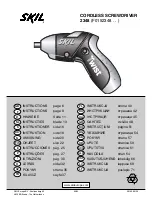
English–4
1 619 929 563 • (02.12) T
Putting into Operation
Ensure that the mains voltage is correct!
The voltage of the power source must agree with the
value given on the nameplate of the machine. Ma-
chines designated for 230 V can also be operated with
220 V.
Set the Operating Mode
With the operating mode selector switch
7
, select the
operating mode of the machine.
Change the operating mode only when the ma-
chine is switched off!
Otherwise, the machine can
be damaged.
To change the operating mode, press the locking but-
ton
8
and turn the operating mode selector switch
7
to
the desired position until it can be heard to latch.
For hammer drilling in concrete or stone
and for chiselling.
For drilling in steel or wood, for driving
screws and cutting threads.
Setting the Direction of Rotation (GBH 2-22 RE)
With the right/left rotation switch
4
, the rotational di-
rection of the machine can be changed
(see Fig.
).
Right rotation: Turn the right/left rotation switch
4
on
both sides to position
.
Left rotation:
Turn the right/left rotation switch
4
on
both sides to position
.
Switching On/Off
To
switch on
the machine, press the on/off switch
6
.
To
lock on
, press the on/off switch
6
and lock by
pressing the locking button
5
.
To
switch off
, release the on/off switch
6
. When
locked, first press the on/off switch
6
and then release.
Setting the Speed (GBH 2-22 E/GBH 2-22 RE)
By increasing or decreasing the pressure on the on/off
switch
6
, the speed of the switched-on machine can
be continuously regulated.
Reduced speed of the machine facilitates the starting
of holes (e.g., on smooth surfaces such as tiles), pre-
vents the slipping of the drill and the splintering of the
drilled hole.
Recommended Speed Ranges:
–
High speed for hammer drilling in concrete or stone
as well as for chiselling
–
High speed for drilling in steel
–
Medium speed for drilling in wood
–
Low speed for driving screws and cutting threads.
Working Instructions
Chiselling
For chiselling, a SDS-plus chiselling attachment
MV 200 (accessory) is required that is placed on the
tool holder.
Working with Tools without SDS-Plus
Do not use tools without SDS-plus for hammer
drilling!
Tools without SDS-plus and their holder
(e.g., drill chuck) would be damaged by hammer drill-
ing.
When working with tool without SDS-plus, set the op-
erating mode selector switch
7
to position .
Drilling
To work with tools without SDS-plus (e.g., drills with
cylindrical shafts), a suitable drill chuck must be used.
Screw the SDS-plus adapter shaft
14
(accessory) into
a ring-gear or quick clamping drill chuck
13
(see
Fig. ).
Clean the adapter shaft and lightly grease the insertion
end before inserting.
Insert the shaft of the assembled drill chuck
15
with a
twisting motion into the tool holder
1
until it can be
heard to lock
(see Fig.
).
The adapter shaft locks itself. Check the locking by
pulling on the drill chuck.
To remove the drill chuck
15
, pull the locking sleeve
3
to the rear, hold in this position and remove the drill
chuck from the tool holder.
Screw driving
To use screwdriver bits, a universal holder with SDS-
plus shaft
16
(accessory) is required.
Clean the adapter shaft and lightly grease the insertion
end before inserting.
Insert the universal holder
16
with a twisting motion
into the tool holder
1
until it locks
(see Fig.
).
The universal holder locks itself. Check the locking by
pulling on the universal holder.
Insert a screwdriver bit into the universal holder.
To remove the universal holder
16
, pull the locking
sleeve
3
to the rear, hold it in this position and remove
the universal holder from the tool holder.
F
G
G
H













































